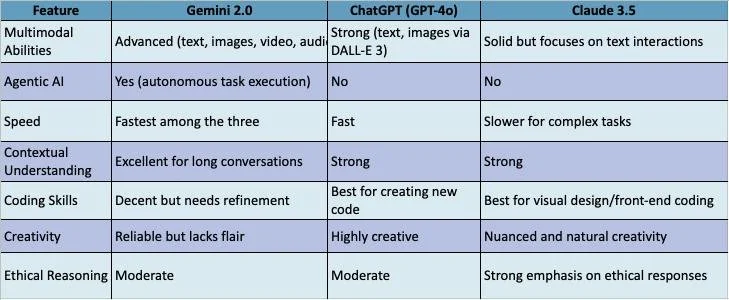Google Unveils Gemini 2.0: A Leap Ahead of Gemini 1.5
Google has unveiled Gemini 2.0, the latest iteration of its advanced AI model, marking a transformative step in the evolution of artificial intelligence. Designed to enhance speed, multimodal capabilities, and autonomous functionality, Gemini 2.0 is poised to revolutionize how AI integrates into everyday tools and professional applications.
Key Features of Gemini 2.0
Enhanced Performance Gemini 2.0 Flash, the first version released, operates at double the speed of its predecessor while maintaining high-performance levels. It matches the capabilities of Google’s Pro model but at a significantly more cost-effective rate, offering a powerful and efficient AI solution.
Multimodal Capabilities A standout feature of Gemini 2.0 is its native multimodal abilities. The model can:
Generate images and audio directly.
Process and understand diverse inputs, including text, images, video, and sound.
Deliver real-time text, image, and audio outputs, creating seamless and dynamic interactions.
Advanced Reasoning and Coding The model has significantly improved its ability to handle complex logic problems, write and debug code, and explain programming concepts across multiple languages, making it a robust tool for developers and problem solvers alike.
Agentic AI Features Gemini 2.0 signals a move toward "agentic AI" — systems capable of task execution with human oversight. These systems:
Perform tasks on behalf of users.
Understand context and anticipate needs.
Integrate natively with tools like Google Search to enhance usability.
Applications and Integration
Gemini 2.0’s capabilities are already enhancing several Google products and services:
Google Search: AI overviews powered by Gemini 2.0 provide more nuanced and accurate responses for complex queries.
Bard: The updated model delivers more helpful and informative responses.
Project Astra: This visual recognition tool aids in navigation and object identification.
Developer Tools: The Multimodal Live API allows developers to create dynamic applications with real-time data streaming.
Competitive Landscape
As Google pushes forward, competitors like OpenAI, Microsoft, and Anthropic are also innovating in the AI space. Each model has unique strengths tailored to specific needs. Gemini 2.0 shines for interactive, multimodal applications and users embedded in Google's ecosystem. Meanwhile, ChatGPT excels in coding and creativity, while Claude provides nuanced reasoning and ethical considerations. The choice ultimately depends on specific requirements like speed, integration, or task complexity. While Gemini 2.0’s emphasis on multimodal understanding, advanced reasoning, and agentic AI sets it apart, its real impact is yet to be seen. Currently, it is accessible via API in an experimental preview, and its broader success will depend on how effectively it can address user needs and navigate potential challenges.
With Gemini 2.0 available via API in an experimental preview, its full potential is yet to be proven.


